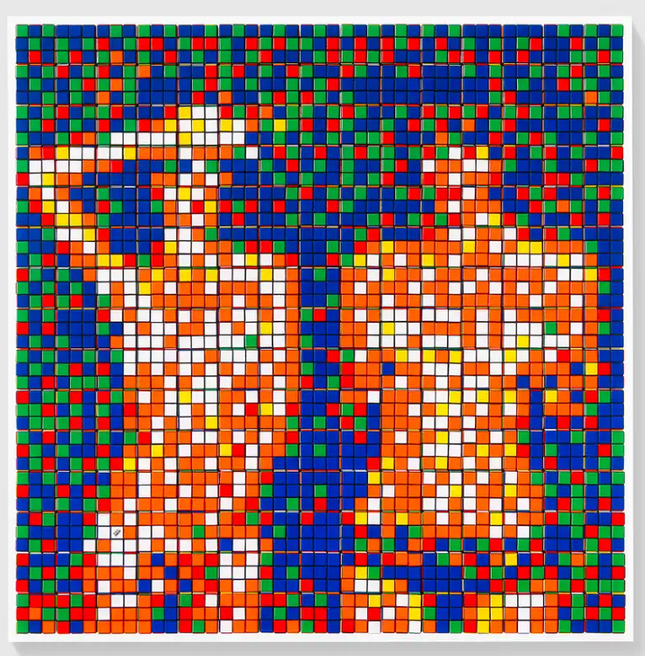
Religion

Invader Rubik Country Life Rubikcubism Metal Giclee Print by Invader
Rubik Country Life Rubikcubism Metal Giclee Print by Invader Artwork Limited Edition Print on Diasec-Mounted Aluminium Composite Panel Graffiti Pop Street Artist. 2023 Signed & Numbered Limited Edition of 431 Artwork Size 39.37x39.37 or 100cmx100cm NVDR1-3. Enhance your space with the "Rubik Rubikcubism Metal Giclee Prints" by the distinguished Invader, a set of four color-drenched, ready-to-hang masterpieces. This acclaimed selection from Invader's Rubik's Cube series transforms playful nostalgia into high art. Each limited edition print is masterfully Diasec-mounted, offering a superior giclée finish on a precision-cut aluminum composite panel. These substantial art pieces measure an impactful 100 x 100 cm and have a notable weight of 13.5kg, ideal for creating a modern and engaging atmosphere. Dive into the world of street pop art with these prints that celebrate Invader's innovative fusion of classic gaming and cutting-edge artistry. Capturing the Essence of Nostalgia: Invader's Rubik Country Life Series The "Rubik Country Life Rubikcubism Metal Giclee Print" by Invader is a modern tribute to the idyllic pastoral scenes, reimagined through the pixelated lens of Rubik's Cubes, bringing a unique fusion of nostalgia and contemporary art to the fore. As a leading figure in the graffiti pop street art movement, Invader's work continues to challenge and redefine the boundaries of art and technology. His 2023 signed and numbered limited edition of 431 pieces, each measuring 100cm by 100cm, represents a bold statement in the art community, marrying the playful simplicity of the Rubik's Cube with the complexity of fine art. Each print in the "Rubik Country Life" series is an intricate composition of Diasec-mounted Giclée on a laser-cut aluminum composite panel weighing 13.5kg. The choice of material speaks to the durability and longevity of the artwork, ensuring that the vibrant mosaics of rural life endure as a lasting piece of cultural expression. These ready-to-hang prints showcase Invader's artistic skill and encapsulate his vision of bringing street pop art and graffiti artwork into a new realm of recognition and appreciation. Invader's Artistic Journey and the Innovation of Rubikcubism Invader's artistic journey is marked by his innovative approach to street pop art, which he has aptly named "Rubikcubism." This technique involves using the iconic Rubik's Cube to create elaborate mosaics that, from a distance, merge into recognizable images. With the "Rubik Country Life" series, Invader weaves a visual narrative that resonates with the tranquility and beauty of rural landscapes, transformed into a grid of colored squares that captivate and intrigue the viewer. The artist's signature method is a technical feat and a conceptual bridge connecting the tactile engagement of solving a Rubik's Cube with the visual experience of appreciating a work of art. Each cube is a pixel, a single component in a larger image that collectively presents a cohesive and striking depiction of country life. This approach pays homage to the early days of digital art and the historical genre of landscape painting, reinterpreted through a modern-day prism. The Cultural Significance of Invader's Limited Edition Prints The limited edition nature of the "Rubik Country Life" series elevates these prints beyond mere artistic creations; they become cultural artifacts. Each signed and numbered piece signifies its place in the lineage of street pop art, marking Invader's impact on the art world. Collectors and enthusiasts of Invader's work can own a segment of this historical narrative, as each print becomes a testament to the evolving landscape of street art. Invader's prints are important for their visual impact and their role in the discourse of street art's place within the art historical canon. The "Rubik Country Life" series and its counterparts demonstrate the potential for street art to transcend its temporary nature and to be celebrated and preserved as high art. This reflects the shifting perceptions surrounding graffiti and street pop art, with Invader at the forefront of this transformation. The "Rubik Country Life Rubikcubism Metal Giclee Print" series is a vibrant example of how street pop art intersects with traditional art forms to create something entirely new and profoundly impactful. Invader's work, with its distinctive aesthetic and cultural resonance, continues to inspire and challenge viewers, cementing his status as an innovator and a pivotal figure in contemporary art.
$14,114.00


